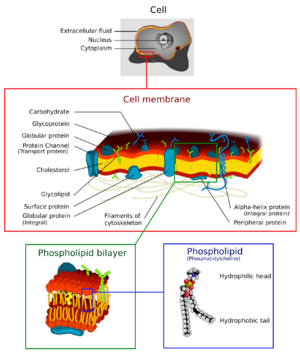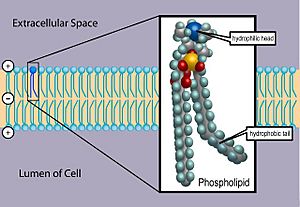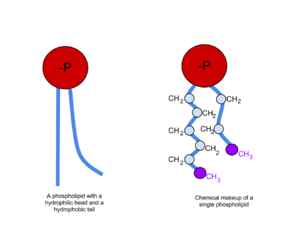Phospholipid facts for kids

Phospholipids are a special type of fat that contain phosphorus. They are super important because they make up the main part of all cell membranes. Think of cell membranes as the protective skin around every cell in your body! Phospholipids form something called a lipid bilayer, which is like a double layer that creates this barrier.
Each phospholipid molecule has two main parts: a "head" and a "tail." The head loves water (it's hydrophilic), and the tails hate water (they're hydrophobic). This unique structure helps them form the cell membrane. In cells, especially in living things called eukaryotes (like plants, animals, and fungi), you'll also find other fats called sterols mixed in with the phospholipids. These sterols help the cell membrane stay flexible and strong.
Contents
What are Phospholipids?
Phospholipids are a type of fat molecule. What makes them special is that they contain a phosphate group, which is a chemical part with phosphorus. This phosphate group gives the "head" of the molecule its water-loving properties.
How Phospholipids Build Cell Membranes
Imagine tiny building blocks that can arrange themselves perfectly to create a wall. That's what phospholipids do for cells!
- The Water-Loving Head: This part of the phospholipid is attracted to water. It faces outwards towards the watery environment inside and outside the cell.
- The Water-Hating Tails: These two tails are made of fatty acids and try to avoid water. They face inwards, away from the water, meeting in the middle of the membrane.
Because of this, phospholipids naturally form a double layer called a lipid bilayer. The water-loving heads are on the outside, and the water-hating tails are tucked safely on the inside. This bilayer creates a strong, flexible barrier that controls what goes in and out of the cell.
Why are Cell Membranes Important?
Cell membranes are vital for life. They act like a gatekeeper, protecting the cell and allowing only certain things to pass through. This helps the cell maintain its internal balance. Phospholipids, along with other molecules like proteins and sterols, work together to make sure the cell membrane is fluid (can move and change shape) and strong enough to protect the cell.
Other Uses of Phospholipids
Besides their crucial role in living cells, phospholipids are also used in other ways. Scientists and engineers use purified phospholipids in new technologies, like nanotechnology (working with super tiny materials) and materials science. For example, they can be used to create tiny bubbles called liposomes that can deliver medicines inside the body.
Images for kids
See also
 In Spanish: Fosfolípido para niños
In Spanish: Fosfolípido para niños




